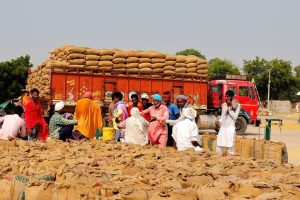Leveraging NGOs to Disseminate Meso-Level Insurance

Image by Rinku Dua on ShutterStock
A majority of the Indian Government’s recent efforts has laid emphasis on farmers’ well-being. In 2016, the government proposed the ambitious goal of doubling Indian farmers’ income by 2022. This requires engagement from multiple stakeholders — the government, the private sector and the civil society. Non-governmental organizations (NGOs) have been playing a critical role in agriculture and farming area development, especially in rural and underprivileged areas. While data for the number of NGOs working in India is limited. As of 2016, an estimated 31 lakh NGOs, across all sectors are registered under the Societies Registration Act, out of which 2.9 Lakh have complied with the requirement of submitting balance sheets and income-expenditure statements with the Registrar of Societies in 2017. Going by even a conservative estimate, this would suggest that a sizable number of NGOs work with rural households predominantly engaged in agriculture.
Popular among the programmes run by NGOs for farming community are capacity building, livelihood development, sustainable agriculture, market linkages, farm productivity improvement and increasing overall farm income, which, in the wake of the COVID-19 pandemic, have gained more prominence. The government too acknowledges the role of NGOs as conduits in reaching out to rural communities in India. NITI Aayog has contacted more than 90,000 NGOsand civil society organisations (CSO) in the first week of May 2020 for assistance to deliver services to the poor as well as health and community workers.
Building the economic resilience of farming households is the key aspect of these programmes. However, a key challenge for NGOs working with farmers is how to sustain their own operations.
The portfolio of services that NGOs offer are vulnerable to the extent that they may get disrupted by the adverse circumstances the recipients may have to countenance. For instance, natural calamities such as floods or drought or unforeseen revenue losses due to pandemics may result in widespread default or delay in repayment of seasonal loans extended by the NGOs. Another instance is NGOs offering agricultural inputs to farmers at the onset of the season, expecting repayments on completion of harvest. If there is a crop failure and the farmer is unable to pay back on time, the NGO has to absorb the burden, affecting their liquidity and hampering their other operations. While the stakeholders we interacted with for this study did not report large-scale defaults of this nature, the absence of a formal risk management mechanism leaves the NGOs vulnerable to risks as climatic changes increase risk of crop losses.
Meso-level insurance can act as a risk management mechanism, as highlighted in our previous blog on Oxfam’s experiences with Manab Mukti Sangstha, an NGO in the flood-prone districts of Bangladesh. Payouts to the NGO on the portfolio insured by them, triggered by a flood-based index ensured that timely liquidity was available to the NGO to sustain its operations. At the same time, a large portion of the payouts was used in the relief and rehabilitation efforts undertaken by it.
Meso-insurance could be useful for NGOs that promote adoption of new technology or best practices by farmers, such as a new variety of seeds. The farmers may be reluctant to participate because of the unknown risks associated with it. To mitigate the farmers’ reservations, the NGO could work out a financial compensation model for the farmers, by insuring itself against associated risks, using an index-based mechanism.
Another potential application for NGOs as an intermediary can be to cover some of the unexpected residual risks. For instance, several NGOs that promote Farmer Producer Organizations (FPOs) play an active role in developing forward linkages for the marketing and sale of farmers’ produce. Our interactions with stakeholders revealed that, on an average, up to ten per cent of the harvest is lost due to storage inefficiencies or transportation losses. While payments are often made to the farmers during procurement, the NGO ends up absorbing these losses. Customized meso-level solutions on the lines of products such as marine covers that are commonly used by businesses to insure losses due to transportation and storage can be implemented here.
With the NGOs having the trust of the farming community, any risk mitigation solution introduced through them should find wider acceptance. NGOs too need support in their functioning and a mechanism to underwrite the potential losses they end up bearing on behalf of the farmers. In this scenario, meso-insurance products will find a good market with NGOs.
This research was developed as part of the Bharat Inclusion Research Fellowship.
